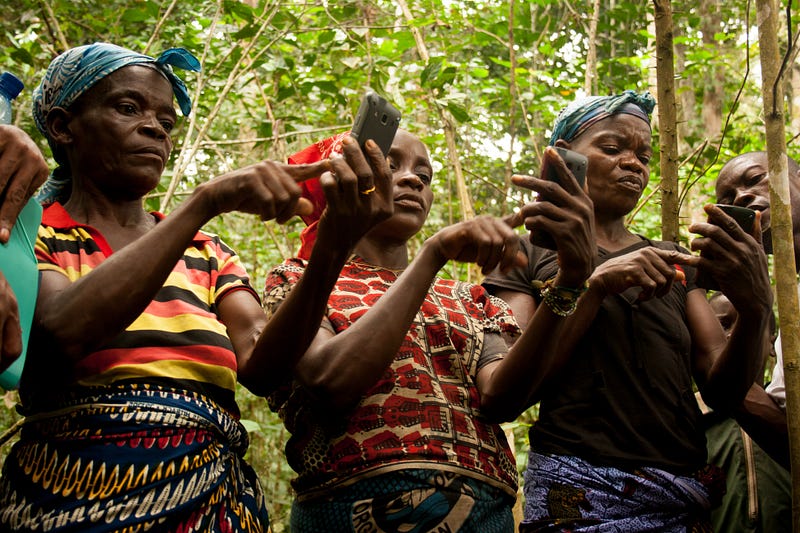How Citizen Scientists Are Revolutionizing Data Collection
چگونه دانشمندان شهروند در جمع آوری داده ها در حال انقلاب کردن هستند
Throughout the world, citizen scientists are developing tools to better manage world’s resources. Meet four such innovators who will be featured in an upcoming data innovation showcase in Abu Dhabi.
در سراسر جهان، دانشمندان شهروند در حال توسعه ابزاری هستند برای مدیریت بهتر منابع جهان . با چهار نفر ازآنها که در ویترین نوآوری داده های آینده در ابوظبی . حضور خواهند رساند آشنا شوید

Documenting
science has never been more visible or democratic. Entwined with
scientists and activists from the Congo Basin to the Peruvian Rainforest
to innovation labs at MIT — crowdsourcing technology has created new
data capacities.
Airscapes Singapore, crowdsourcing air pollution
With her team at MIT’s Senseable City Lab,
Environmental Epidemiologist Marguerite Nyhan visualizes crowdsourced
air quality data so people can make informed decisions about their daily
habits and avoid exposure to high levels of pollution.
“Our work has the potential to inform urban populations of the health impacts of air pollution, which is now recognized as the world’s most pressing environmental and human health threat,” says Nyhan.
Her project, Airscapes Singapore, is the winner of the Data Visualization Challenge for Eye on Earth,
a major environmental Summit coming up in Abu Dhabi. Nyhan says the
Summit aims to promote dialogue to revolutionize the way scientists
collect, access, share, and use data for affecting real-world change on
environmental issues.

“We would like our project to be recognized internationally as having the potential to make a significant positive impact on the health of urban populations all over the world,” Nyhan says.
Logging roads in the Congo Basin Rainforest
In
the Congo Basin, geography students, activists, scientists and local
officials are using crowdsourcing to monitor forests. Leo Bottrill is
the Founder and project leader at Moabi,
an organization that collaboratively monitors natural resource use in
the Democratic Republic of the Congo. Through Moabi’s leadership,
citizen mappers have made over 5,000 edits to a crowdsourced map of
logging roads on OpenStreetMap , an open geographic database.
“The validated DRC logging roads provide a vital dataset to determine whether logging companies have committed violations,” Bottrill explains.
Bottrill
notes that all data collected goes through a validation process to
ensure the accuracy of user contributions. Once it has been validated,
the data can be used by independent monitoring organizations and
government authorities to determine whether logging companies have
committed any violations to their forest management plan. Bottrill is
also looking at developing broader national resource monitoring tools in
collaboration with local and international partners.
Hack the Rainforest, combining new technology with indigenous wisdom
Deep
in the Peruvian Amazon, indigenous communities are also holding
governments and companies accountable for illegal logging and oil
contaminations. The team at Hack the Rainforest
is bringing together environmental monitors and collaborating with
software developers and designers to prototype a mobile data collection
app to monitor environmental abuses in remote areas.

Back
in February 2014, participants from four indigenous communities and 12
countries including Chile, the U.S. and Israel spent five-days in the
city of Tarapoto known as the cloud forest of northern Peru. This
unprecedented hackathon took place in coordination with Digital Democracy,
an organization that works with marginalized communities around the
world on technology solutions to local environmental challenges.
“This iterative design process is improving how local communities gather evidence of oil spills, deforestation and illegal mining,” say Emily Jacobi of Digital Democracy.
Hyperlocal Biodiversity Data Collection Game
Say
you’re walking with your kids in the woods and come across an
interesting plant or insect, you take a photo and upload it to Biocaching, a data game that allows your information to be shared with national and international databases.
“Your single sighting of an insect may not seem to have scientific significance,” says Bjørn Hjelle, Founder of Biocaching. “But as part of a larger dataset each observation is a valuable contribution to big data analytics performed by scientists to discover trends and to better understand the dynamics of nature,” Hjelle adds.
Hjelle
notes that players are also rewarded with points and ‘likes’ and can
compete or cooperate with others. The Biocaching team met in June 2015
at a hackathon in Norway. Their project took home an award for “Most
Useful for Society”. They are currently focused on developing the
concept, studying available biodiversity web services, and prototyping.
These
four project teams will present at the Eye on Earth Summit in Abu Dhabi
October 6–8, 2015 as part of the Data Innovation Showcase presented by
the Eye on Earth Alliance. They’ll showcase their work and emphasize the
importance of data in measuring not only progress towards sustainable
development but also ways to hold companies and governments accountable.
During the Summit, the winner of the Citizen Science Challenge will be announced.
Abu
Dhabi’s Secretary General for Environment, Razan Al Mubarak says it’s
imperative to close the data gap by engaging civil society with
scientists and governments around the world.
Razan Al Mubarak, Abu Dhabi’s Secretary General for the Environment.
In a recent editorial in Nature,
doubts were raised about the rise of citizen scientists and the
potential motive some might have to use data for political purposes.
“Opponents of fracking, for example, might help to track possible
pollution because they want to gather evidence of harmful effects,” the
Nature editorial states. What’s emerging ahead of the Eye on Earth
Summit however, is a sense that public-private collaborations around
data innovation might well be the wave of the future. Keep your eyes on
#DataRevolution and #EOESummit15 to discover more about these and other
innovators.
******************************
About the authors: Davar Ardalan is the Director of Storytelling and Engagement at SecondMuse.
Lena Delchad is the Engagement Manager for Eye on Earth’s Data
Innovation Showcase. SecondMuse is one of the partners in this open
innovation endeavor.
No comments:
Post a Comment